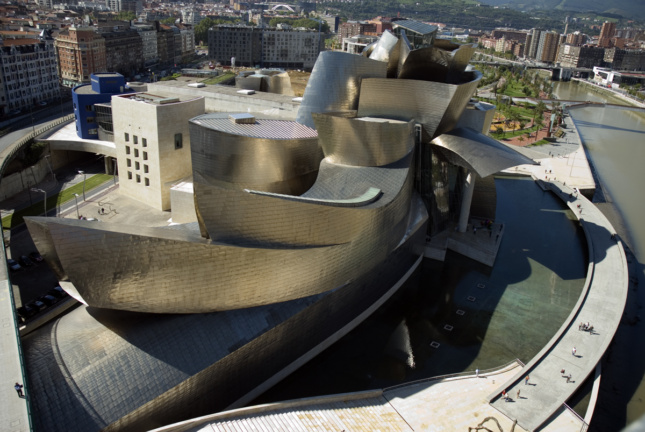
A new exhibition at the Guggenheim Museum Bilbao looks back on the historic design and construction of the seminal Spanish museum and its pioneering use of digital technology and avant-garde materials in the field. Architectural Effects, which opened on December 5, details Frank Gehry’s pivotal project while chronicling its influence on contemporary architecture and art.
Organized by lead curator Manuel Cirauqui and Troy Conrad Therrien, curator of architecture and digital initiatives at the Solomon R. Guggenheim Museum in New York, the show asks: What makes architecture more than just a building? Through various mediums, the exhibition broadens the understanding of the museum’s initial impact by placing its technological and cultural achievements alongside other 21st-century works.
The exhibition is split into three connected “territories.” In Airlock, the Garden, and the Bubble (a digital dimension available on a free app), visitors can explore both the materials on view as well as the virtual story of architectural advancement visible throughout the show.
Airlock, the introductory territory, features major moments in the creation of groundbreaking digital technology, not just in architecture, but also in biology, pop culture, medicine, politics, and more. Video, audio, books, photographs, historic artifacts, and archival material populate this showcase, further explaining how these benchmarks—all made in the year 1997 when Gehry’s Guggenheim Bilbao was completed—have influenced the world at large.
According to a statement, “The Airlock is a representation of the techno-cultural conditions in which the Guggenheim Museum Bilbao was developed to immediately become a global emblem.” Gehry’s vision for the project and the resulting Bilbao Effect are also heavily documented in this section of the exhibit.
Garden, the main space in Architectural Effects, highlights post-1997 art and architecture through moving images, prototypes, models, sculptures, and artificial intelligence. It features works by prominent artists and architects over the last 20 years through drawings, animation, and architectural documentation. Three major projects are debuted in this section including El Otro by Frida Escobedo, A Tent without a Signal by MOS Architects, and Float Tank 01 by Leong Leong.
Bubble offers visitors an online collection of media that contextualize and further illustrate the works on view. It includes educational materials and readings by influential artists, scholars, and writers like John Mernick, Gordon White, and Venkatesh Rao as well as critical essays by the exhibit’s curators and assistant curator Ashley Mendelsohn.
Architectural Effects is on view through April 28, 2019, at the Guggenheim Museum Bilbao in Bilbao, Spain. Several talks, performances, and workshops will coincide with the exhibition. More information is available here.